MG-63 and FetMSC Cell Response on Atomic Layer Deposited TiO2 Nanolayers Prepared Using Titanium Tetrachloride and Tetraisopropoxide
Abstract
:1. Introduction
2. Materials and Methods
2.1. Supports Preparation
2.2. Atomic Layer Deposition of TiO2
2.3. Study of the Thickness and Morphology of TiO2 Coatings
2.4. Study of the Structure and Composition of TiO2 Coatings
2.5. In Vitro Assessment of the Cellular Response
2.5.1. Cell Culture
2.5.2. Cell Morphology
2.5.3. Cell Viability
2.5.4. Cell Osteogenic Differentiation Assessments
2.5.5. Statistical Analysis
2.6. Study of Mineralization
3. Results
3.1. Atomic Layer Deposition of TiO2 Nanocoating on Silicon Substrate
3.1.1. Thickness and Morphology of TiO2 Nanocoatings
3.1.2. Crystal Structure of TiO2 Nanocoatings
3.2. Atomic Layer Deposition of TiO2 Nanocoatings on Titanium Surface
3.2.1. Thickness and Morphology of TiO2 Nanocoatings
3.2.2. Chemical Composition and Surface Free Energy of the TiO2 Nanocoatings
3.3. In Vitro Study of TiO2 Nanocoatings on Titanium Surface
4. Discussion
5. Conclusions
Supplementary Materials
Author Contributions
Funding
Institutional Review Board Statement
Informed Consent Statement
Data Availability Statement
Acknowledgments
Conflicts of Interest
References
- Jalali, F.; Oveisi, H.; Meshkini, A. Enhanced osteogenesis properties of titanium implant materials by highly uniform mesoporous thin films of hydroxyapatite and titania intermediate layer. J. Mater. Sci. Mater. Med. 2020, 31, 114. [Google Scholar] [CrossRef] [PubMed]
- Chuang, Y.-C.; Wang, L.; Feng, K.-C.; Subramanian, A.; Chang, C.-C.; Simon, M.; Nam, C.-Y.; Rafailovich, M. The Role of Titania Surface Coating by Atomic Layer Deposition in Improving Osteogenic Differentiation and Hard Tissue Formation of Dental Pulp Stem Cells. Adv. Eng. Mater. 2021, 23, 2100097. [Google Scholar] [CrossRef]
- Smietana, M.; Koba, M.; Brzozowska, E.; Krogulski, K.; Nakonieczny, J.; Wachnicki, L.; Mikulic, P.; Godlewski, M.; Bock, W.J. Label-free sensitivity of long-period gratings enhanced by atomic layer deposited TiO2 nano-overlays. Opt. Express 2015, 23, 8441–8453. [Google Scholar] [CrossRef] [PubMed] [Green Version]
- Bilo, F.; Borgese, L.; Prost, J.; Rauwolf, M.; Turyanskaya, A.; Wobrauschek, P.; Kregsamer, P.; Streli, C.; Pazzaglia, U.; Depero, L.E. Atomic layer deposition to prevent metal transfer from implants: An X-ray fluorescence study. Appl. Surf. Sci. 2015, 359, 215–220. [Google Scholar] [CrossRef]
- Mansoorianfar, M.; Tavoosi, M.; Mozafarinia, R.; Ghasemi, A.; Doostmohammadi, A. Preparation and characterization of TiO2 nanotube arrays on Ti6Al4V surface for enhancement of cell treatment. Surf. Coat. Technol. 2017, 321, 409–415. [Google Scholar] [CrossRef]
- Wu, J.-M. Nanostructured TiO2 layers on Ti for bone bonding. In Bioceramics; Osaka, A., Narayan, R., Eds.; Elsevier Ltd.: Amsterdam, The Netherlands, 2021; pp. 25–76. [Google Scholar] [CrossRef]
- Peron, M.; Bin Afif, A.; Dadlani, A.L.; Berto, F.; Torgersen, J. Improving stress corrosion cracking behavior of AZ31 alloy with conformal thin titania and zirconia coatings for biomedical applications. J. Mech. Behav. Biomed. Mater. 2020, 111, 104005. [Google Scholar] [CrossRef]
- Hashemi Astaneh, S.; Faverani, L.P.; Sukotjo, C.; Takoudis, C.G. Atomic layer deposition on dental materials: Processing conditions and surface functionalization to improve physical, chemical, and clinical properties—A review. Acta Biomater. 2021, 121, 103–118. [Google Scholar] [CrossRef]
- Pessoa, R.S.; dos Santos, V.P.; Cardoso, S.B.; Doria, A.C.O.C.; Figueira, F.R.; Rodrigues, B.V.M.; Testoni, G.E.; Fraga, M.A.; Marciano, F.R.; Lobo, A.O.; et al. TiO2 coatings via atomic layer deposition on polyurethane and polydimethylsiloxane substrates: Properties and effects on C. albicans growth and inactivation process. Appl. Surf. Sci. 2017, 422, 73–84. [Google Scholar] [CrossRef]
- Mansoorianfar, M.; Khataee, A.; Riahi, Z.; Shahin, K.; Asadnia, M.; Razmjou, A.; Hojjati-Najafabadi, A.; Mei, C.; Orooji, Y.; Li, D. Scalable fabrication of tunable titanium nanotubes via sonoelectrochemical process for biomedical applications. Ultrason. Sonochem. 2020, 64, 104783. [Google Scholar] [CrossRef]
- Grigal, I.P.; Markeev, A.M.; Gudkova, S.A.; Chernikova, A.G.; Mityaev, A.S.; Alekhin, A.P. Correlation between bioactivity and structural properties of titanium dioxide coatings grown by atomic layer deposition. Appl. Surf. Sci. 2012, 258, 3415–3419. [Google Scholar] [CrossRef]
- Miikkulainen, V.; Leskelä, M.; Ritala, M.; Puurunen, R.L. Crystallinity of inorganic films grown by atomic layer deposition: Overview and general trends. J. Appl. Phys. 2013, 113, 021301. [Google Scholar] [CrossRef]
- George, S.M. Atomic Layer Deposition: An Overview. Chem. Rev. 2010, 110, 111–131. [Google Scholar] [CrossRef] [PubMed]
- Niemelä, J.-P.; Marin, G.; Karppinen, M. Titanium dioxide thin films by atomic layer deposition: A review. Semicond. Sci. Technol. 2017, 32, 093005. [Google Scholar] [CrossRef]
- Bishal, A.K.; Sukotjo, C.; Jokisaari, J.R.; Klie, R.F.; Takoudis, C.G. Enhanced Bioactivity of Collagen Fiber Functionalized with Room Temperature Atomic Layer Deposited Titania. ACS Appl. Mater. Interfaces 2018, 10, 34443–34454. [Google Scholar] [CrossRef]
- Blendinger, F.; Seitz, D.; Ottenschlager, A.; Fleischer, M.; Bucher, V. Atomic Layer Deposition of Bioactive TiO2 Thin Films on Polyetheretherketone for Orthopedic Implants. ACS Appl. Mater. Interfaces 2021, 13, 3536–3546. [Google Scholar] [CrossRef]
- Choy, S.; Oh, D.X.; Lee, S.; Lam, D.V.; You, G.; Ahn, J.S.; Lee, S.W.; Jun, S.H.; Lee, S.M.; Hwang, D.S. Tough and Immunosuppressive Titanium-Infiltrated Exoskeleton Matrices for Long-Term Endoskeleton Repair. ACS Appl. Mater. Interfaces 2019, 11, 9786–9793. [Google Scholar] [CrossRef]
- Nguyen, V.P.; Yoo, J.; Lee, J.Y.; Chung, J.J.; Hwang, J.H.; Jung, Y.; Lee, S.M. Enhanced Mechanical Stability and Biodegradability of Ti-Infiltrated Polylactide. ACS Appl. Mater. Interfaces 2020, 12, 43501–43512. [Google Scholar] [CrossRef]
- Motola, M.; Capek, J.; Zazpe, R.; Bacova, J.; Hromadko, L.; Bruckova, L.; Ng, S.; Handl, J.; Spotz, Z.; Knotek, P.; et al. Thin TiO2 Coatings by ALD Enhance the Cell Growth on TiO2 Nanotubular and Flat Substrates. ACS Appl. Bio Mater. 2020, 3, 6447–6456. [Google Scholar] [CrossRef]
- Nazarov, D.V.; Smirnov, V.M.; Zemtsova, E.G.; Yudintceva, N.M.; Shevtsov, M.A.; Valiev, R.Z. Enhanced Osseointegrative Properties of Ultra-Fine-Grained Titanium Implants Modified by Chemical Etching and Atomic Layer Deposition. ACS Biomater. Sci. Eng. 2018, 4, 3268–3281. [Google Scholar] [CrossRef]
- Liu, L.; Bhatia, R.; Webster, T.J. Atomic layer deposition of nano-TiO2 thin films with enhanced biocompatibility and antimicrobial activity for orthopedic implants. Int. J. Nanomed. 2017, 12, 8711–8723. [Google Scholar] [CrossRef] [Green Version]
- Abbas, A.; Hung, H.-Y.; Lin, P.-C.; Yang, K.-C.; Chen, M.-C.; Lin, H.-C.; Han, Y.-Y. Atomic layer deposited TiO2 films on an equiatomic NiTi shape memory alloy for biomedical applications. J. Alloy. Compd. 2021, 886, 161282. [Google Scholar] [CrossRef]
- Yang, F.; Chang, R.; Webster, T.J. Atomic Layer Deposition Coating of TiO2 Nano-Thin Films on Magnesium-Zinc Alloys to Enhance Cytocompatibility for Bioresorbable Vascular Stents. Int. J. Nanomed. 2019, 14, 9955–9970. [Google Scholar] [CrossRef] [PubMed] [Green Version]
- Huang, L.; Su, K.; Zheng, Y.-F.; Yeung, K.W.-K.; Liu, X.-M. Construction of TiO2/silane nanofilm on AZ31 magnesium alloy for controlled degradability and enhanced biocompatibility. Rare Met. 2019, 38, 588–600. [Google Scholar] [CrossRef]
- Nazarov, D.; Zemtsova, E.; Smirnov, V.; Mitrofanov, I.; Maximov, M.; Yudintceva, N.; Shevtsov, M. The Effects of Chemical Etching and Ultra-Fine Grain Structure of Titanium on MG-63 Cells Response. Metals 2021, 11, 510. [Google Scholar] [CrossRef]
- Nazarov, D.V.; Zemtsova, E.G.; Solokhin, A.Y.; Valiev, R.Z.; Smirnov, V.M. Modification of the Surface Topography and Composition of Ultrafine and Coarse Grained Titanium by Chemical Etching. Nanomaterials 2017, 7, 15. [Google Scholar] [CrossRef] [Green Version]
- Nazarov, D.V.; Zemtsova, E.G.; Valiev, R.Z.; Smirnov, V.M. Formation of Micro- and Nanostructures on the Nanotitanium Surface by Chemical Etching and Deposition of Titania Films by Atomic Layer Deposition (ALD). Materials 2015, 8, 8366–8377. [Google Scholar] [CrossRef]
- Nazarov, D.; Rudakova, A.; Borisov, E.; Popovich, A. Surface Modification of Additively Manufactured Nitinol by Wet Chemical Etching. Materials 2021, 14, 7683. [Google Scholar] [CrossRef]
- Owens, D.K.; Wendt, R.C. Estimation of the surface free energy of polymers. J. Appl. Polym. Sci. 1969, 13, 1741–1747. [Google Scholar] [CrossRef]
- Gengenbach, T.R.; Major, G.H.; Linford, M.R.; Easton, C.D. Practical guides for X-ray photoelectron spectroscopy (XPS): Interpreting the carbon 1s spectrum. J. Vac. Sci. Technol. A 2021, 39, 013204. [Google Scholar] [CrossRef]
- Yi, J.-H.; Bernard, C.; Variola, F.; Zalzal, S.F.; Wuest, J.D.; Rosei, F.; Nanci, A. Characterization of a bioactive nanotextured surface created by controlled chemical oxidation of titanium. Surf. Sci. 2006, 600, 4613–4621. [Google Scholar] [CrossRef]
- Lu, X.; Wang, Y.; Yang, X.; Zhang, Q.; Zhao, Z.; Weng, L.T.; Leng, Y. Spectroscopic analysis of titanium surface functional groups under various surface modification and their behaviors in vitro and in vivo. J. Biomed. Mater. Res. A 2008, 84, 523–534. [Google Scholar] [CrossRef] [PubMed]
- Kuznetsov, M.V.; Zhuravlev, J.F.; Zhilyaev, V.A.; Gubanov, V.A. XPS study of the nitrides, oxides and oxynitrides of titanium. J. Electron Spectrosc. Relat. Phenom. 1992, 58, 1–9. [Google Scholar] [CrossRef]
- Biesinger, M.C.; Lau, L.W.M.; Gerson, A.R.; Smart, R.S.C. Resolving surface chemical states in XPS analysis of first row transition metals, oxides and hydroxides: Sc, Ti, V, Cu and Zn. Appl. Surf. Sci. 2010, 257, 887–898. [Google Scholar] [CrossRef]
- Stevens, N.; Priest, C.I.; Sedev, R.; Ralston, J. Wettability of Photoresponsive Titanium Dioxide Surfaces. Langmuir 2003, 19, 3272–3275. [Google Scholar] [CrossRef]
- Bhat, S.; Viswanathan, P.; Chandanala, S.; Prasanna, S.J.; Seetharam, R.N. Expansion and characterization of bone marrow derived human mesenchymal stromal cells in serum-free conditions. Sci. Rep. 2021, 11, 3403. [Google Scholar] [CrossRef]
- Yudintceva, N.M.; Bogolyubova, I.O.; Muraviov, A.N.; Sheykhov, M.G.; Vinogradova, T.I.; Sokolovich, E.G.; Samusenko, I.A.; Shevtsov, M.A. Application of the allogenic mesenchymal stem cells in the therapy of the bladder tuberculosis. J. Tissue Eng. Regen. Med. 2018, 12, e1580–e1593. [Google Scholar] [CrossRef] [PubMed]
- Chatakun, P.; Nunez-Toldra, R.; Diaz Lopez, E.J.; Gil-Recio, C.; Martinez-Sarra, E.; Hernandez-Alfaro, F.; Ferres-Padro, E.; Giner-Tarrida, L.; Atari, M. The effect of five proteins on stem cells used for osteoblast differentiation and proliferation: A current review of the literature. Cell. Mol. Life Sci. 2014, 71, 113–142. [Google Scholar] [CrossRef] [PubMed]
- Stewart, C.; Akhavan, B.; Wise, S.G.; Bilek, M.M.M. A review of biomimetic surface functionalization for boneintegrating orthopedic implants: Mechanisms, current approaches, and future directions. Prog. Mater. Sci. 2019, 106, 100588. [Google Scholar] [CrossRef]
- Majhy, B.; Priyadarshini, P.; Sen, A.K. Effect of surface energy and roughness on cell adhesion and growth—Facile surface modification for enhanced cell culture. RSC Adv. 2021, 11, 15467–15476. [Google Scholar] [CrossRef]
- Lin, Z.; Lee, G.-H.; Liu, C.-M.; Lee, I.-S. Controls in wettability of TiOx films for biomedical applications. Surf. Coat. Technol. 2010, 205, S391–S397. [Google Scholar] [CrossRef]
- Vieira, T.M.; Sagás, J.C.; Pessoa, R.S.; Fontana, L.C. Multiphase titanium suboxides films grown on glass substrate: Surface energy, wettability and morphology analysis. Surf. Interfaces 2020, 20, 100610. [Google Scholar] [CrossRef]
- Hanaor, D.A.H.; Sorrell, C.C. Review of the anatase to rutile phase transformation. J. Mater. Sci. 2010, 46, 855–874. [Google Scholar] [CrossRef] [Green Version]
- Mansoorianfar, M.; Rahighi, R.; Hojjati-Najafabadi, A.; Mei, C.; Li, D. Amorphous/crystalline phase control of nanotubular TiO2 membranes via pressure-engineered anodizing. Mater. Des. 2021, 198, 109314. [Google Scholar] [CrossRef]
- He, J.; Zhou, W.; Zhou, X.; Zhong, X.; Zhang, X.; Wan, P.; Zhu, B.; Chen, W. The anatase phase of nanotopography titania plays an important role on osteoblast cell morphology and proliferation. J. Mater. Sci. Mater. Med. 2008, 19, 3465–3472. [Google Scholar] [CrossRef]
- Matijošius, T.; Pivoriūnas, A.; Čebatariūnienė, A.; Tunaitis, V.; Staišiūnas, L.; Stalnionis, G.; Ručinskienė, A.; Asadauskas, S.J. Friction reduction using Nanothin Titanium layers on anodized aluminum as potential bioceramic material. Ceram. Int. 2020, 46, 15581–15593. [Google Scholar] [CrossRef]
- Solovyev, A.A.; Markeev, A.M.; Tetyukhin, D.V.; Kozlov, E.N.; Molchanov, S.A. Applications of atomic layer deposition in implant dentistry. Eur. Cells Mater. 2014, 27, 17. [Google Scholar]
- Picosun Strengthens Its Presence in the Healthcare Industries. Available online: https://markets.businessinsider.com/news/stocks/picosun-strengthens-its-presence-in-the-healthcare-industries-1028237785 (accessed on 3 May 2022).


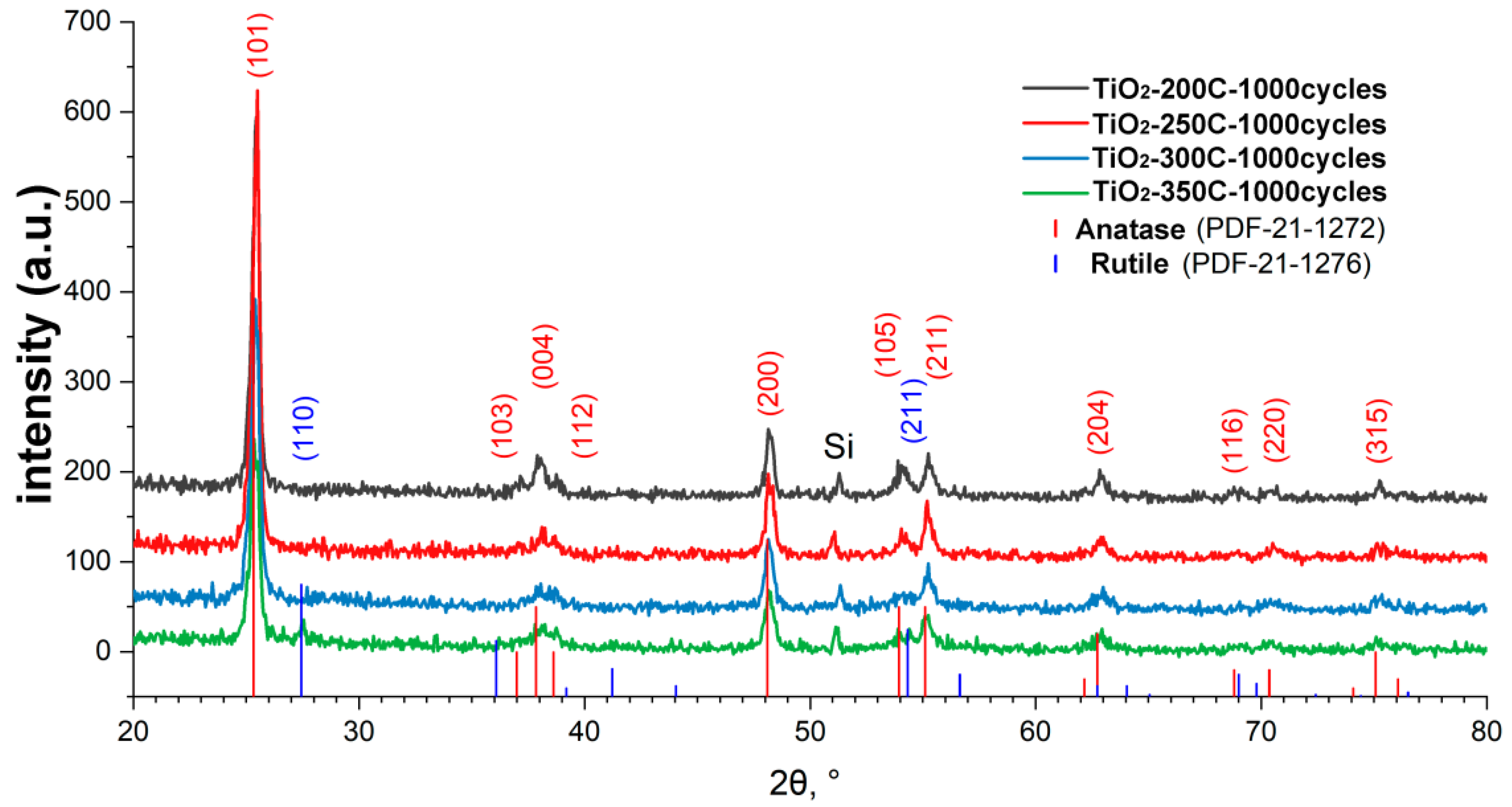
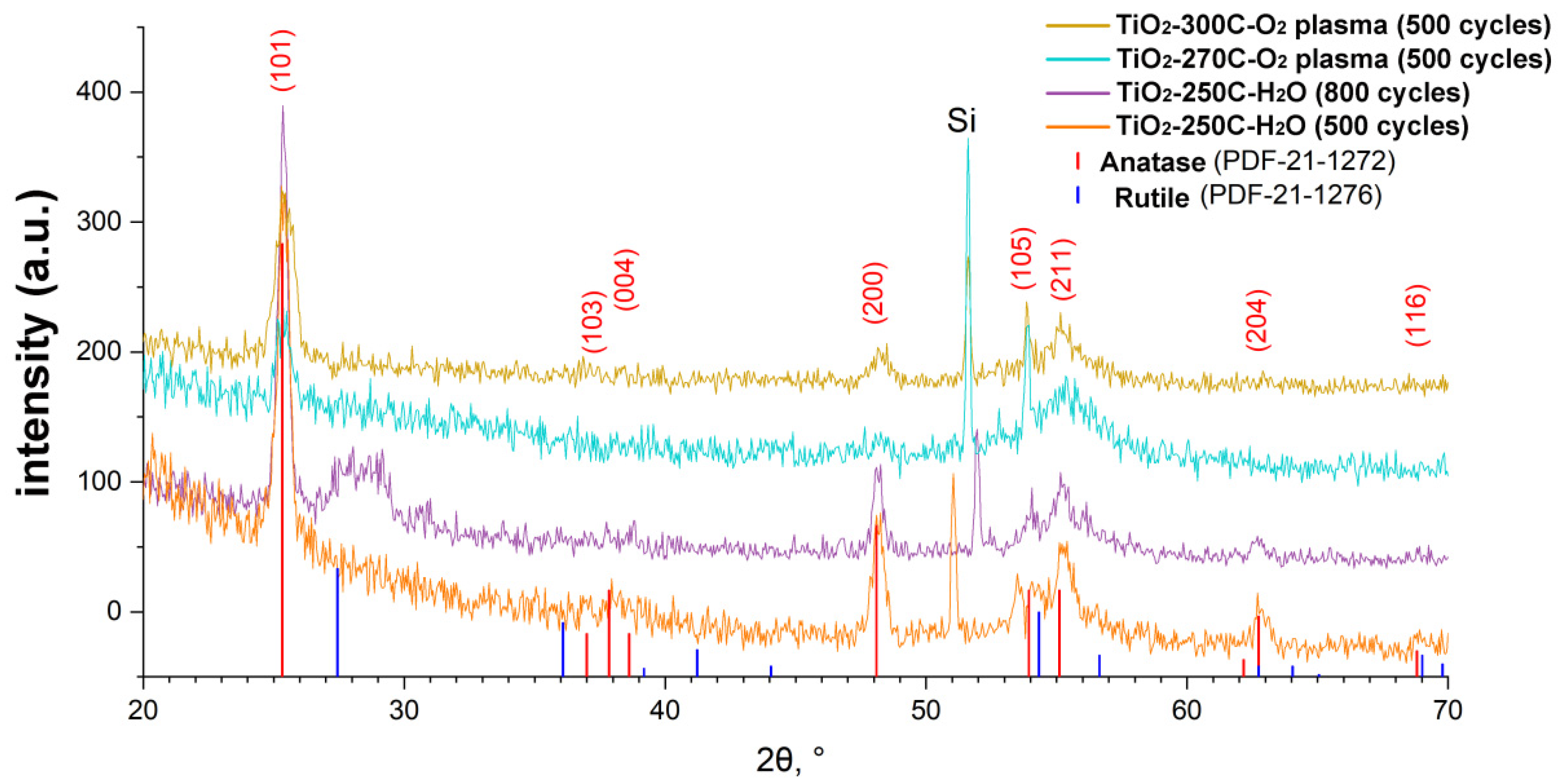

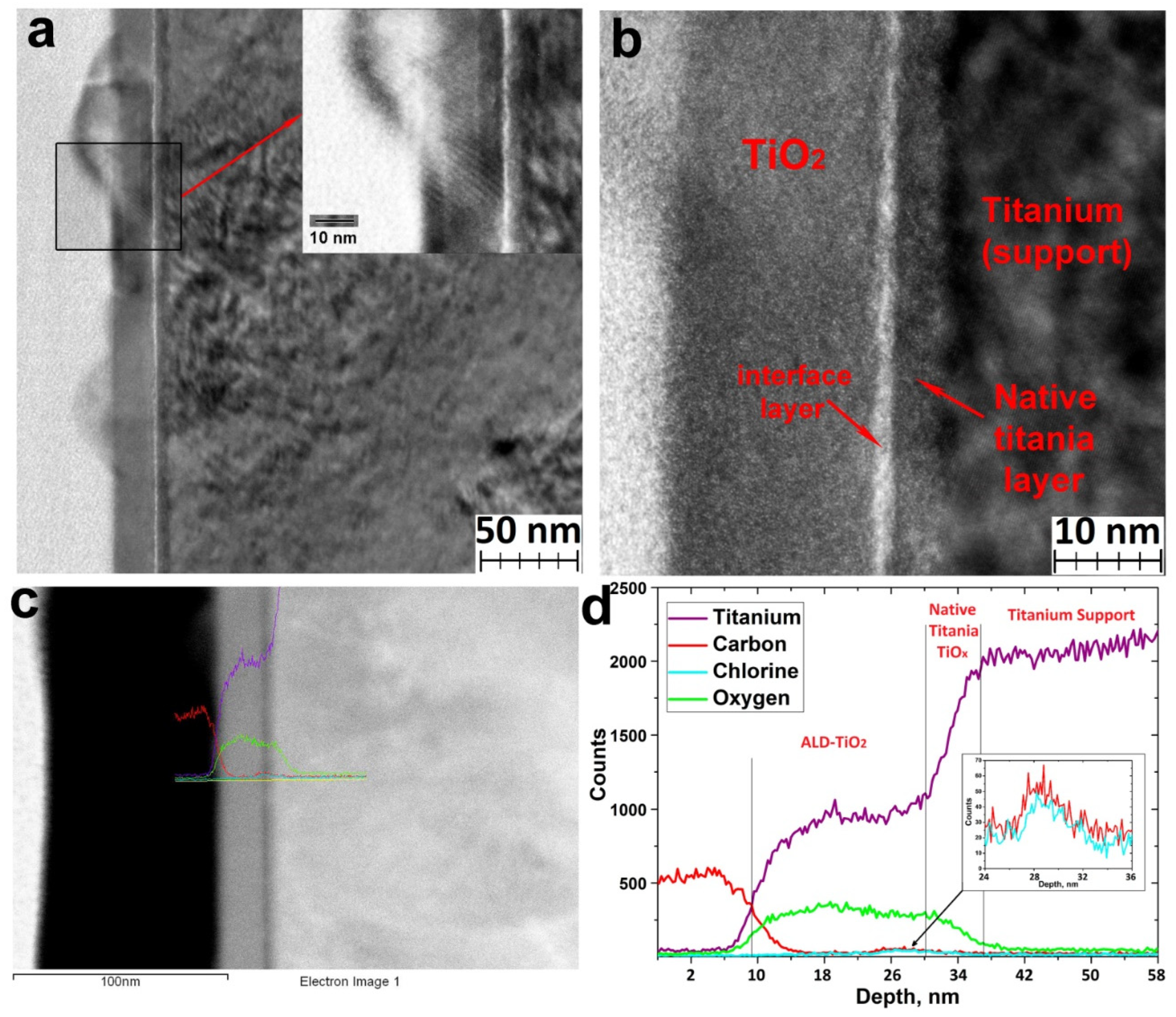
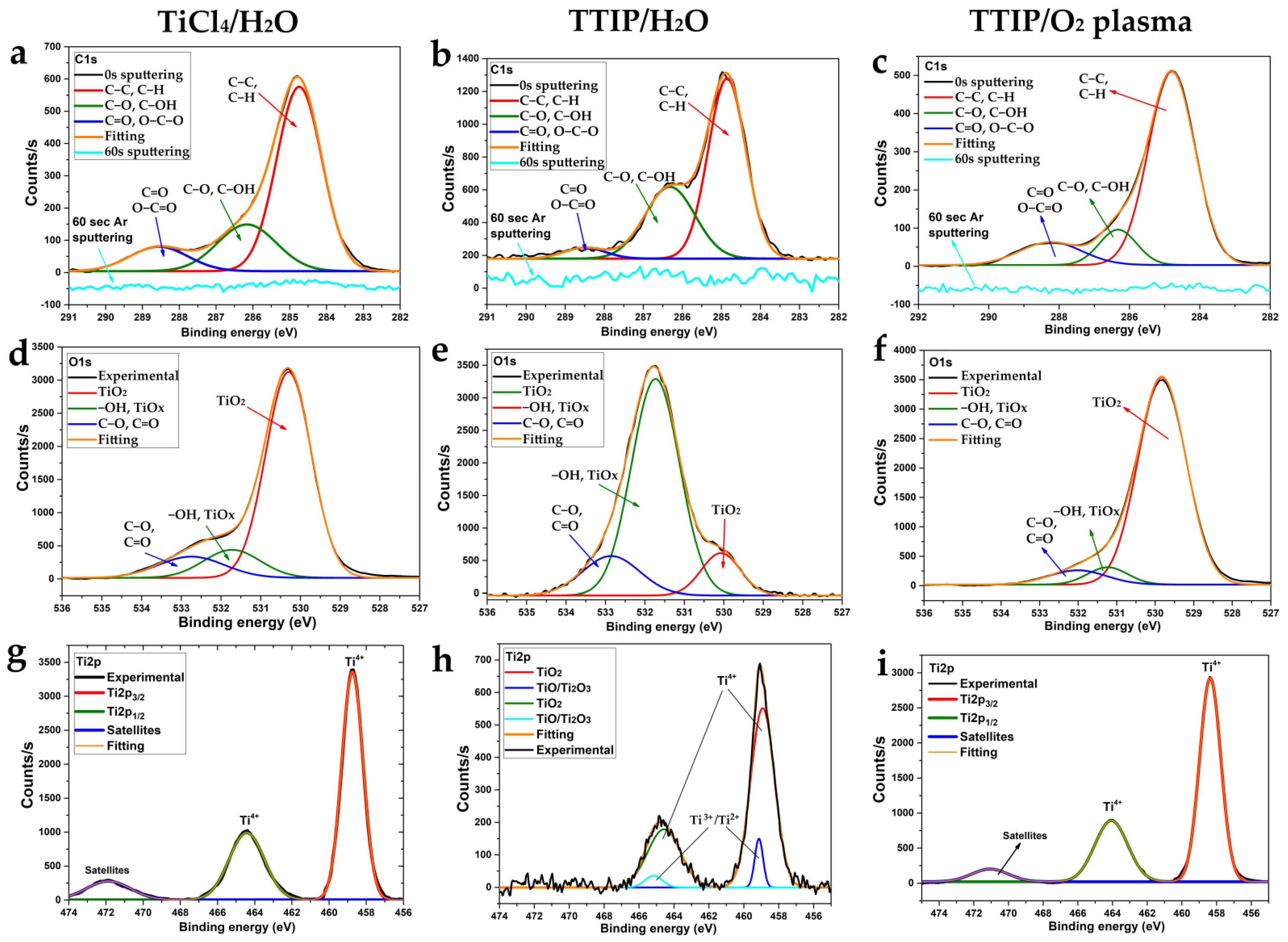

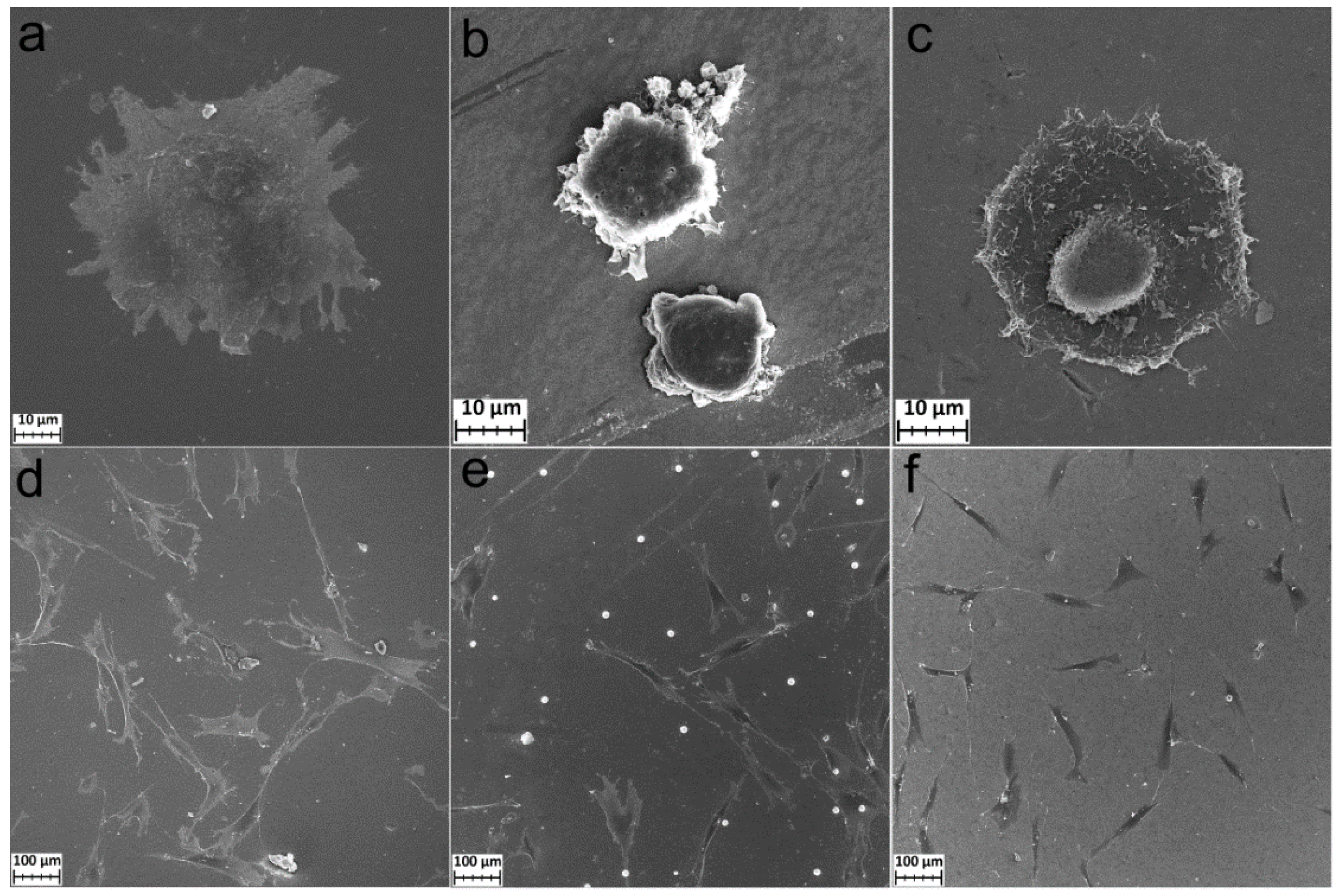




| Sample | Number of ALD Cycles | Thickness by SE (GPC), nm | Thickness (by XRR), nm | Density, g/cm3 | Roughness, nm | |
|---|---|---|---|---|---|---|
| Precursor Pair | Deposition Temperature, °C | |||||
| TiCl4/H2O | 200 °C | 500 | 26.0 ± 2.5 (0.0519) ** | - | - | - |
| 1000 | 56.9 ± 6.8 (0.0569) * | 50.9 | 3.92 | 6.89 | ||
| 250 °C | 500 | 25.8 ± 2.4(0.0516) ** | - | - | - | |
| 1000 | 60.4 ± 8.2 (0.0604) * | 63.5 | 3.91 | 4.67 | ||
| 300 °C | 500 | 36.0 ± 2.5 (0.0720) ** | - | - | - | |
| 1000 | 69.0 ± 11.4 (0.0690) * | 58.2 | 3.87 | 4.07 | ||
| 350 °C | 1000 | 62.1 ± 9.6 (0.0621) * | 60.4 | 3.92 | 4.06 | |
| TTIP/ H2O | 200 °C | 500 | 23.6 ±1.8 (0.0472) ** | - | - | - |
| 220 °C | 3000 | 134.1 ± 0.4.6 (0.0447) ** | - | - | - | |
| 250 °C | 500 | 21.2 ± 3.2 (0.0424) ** | 17.0 | 3.98 | 0.47 | |
| 250 °C | 800 | 35.1 ± 0.9 (0.0439) ** | 26.9 | 4.06 | 0.21 | |
| 250 °C | 1000 | 49.1 ± 2.9 (0.0491) ** | - | - | - | |
| TTIP/ O2 plasma | 250 °C | 400 | 7.5 ± 1.0 (0.0187) ** | - | - | - |
| 270 °C | 500 | 12.8 ± 0.6 (0.0256) ** | 12.7 | 3.84 | 0.14 | |
| 300 °C | 500 | 9.2 ± 1.1 (0.0186) ** | 10.4 | 3.98 | 0.44 | |
| Sample | Contact Angles, ° | Total SFE, mN/m | Polar SFE, mN/m | Dispersive SFE, mN/m |
|---|---|---|---|---|
| Ti | 76 | 37.9 | 7.6 | 30.2 |
| TiO2 (TiCl4/H2O) | 91 | 34.0 | 1.6 | 32.4 |
| TiO2 (TTIP/H2O) | 74 | 39.4 | 8.3 | 31.1 |
| Precursors, Temperature, Thickness (nm), Substrate | Crystallinity, Morphology Wettability | Cell Lines | Titanium Dioxide Effect | Ref. |
|---|---|---|---|---|
| TDMATi/O2 plasma, 250 °C, 4–16 nm NiTi | amorphous, uniformal, hydrophilic (62°) | MG-63 osteoblasts | Enhances cell adhesion, promotes cell proliferation, and reduces cytotoxicity. Increase in thickness improves positive effect | [22] |
| TTIP/H2O, 80 °C 3.4 nm polybutadiene | ultrathin coatings | dental pulp stem cells (DPSCs) | Improvement in adhesion and proliferation DPSCs, regulation of osteopontin and bone sialoprotein, representing osteogenic differentiation. Improved the ability to nucleate banded collagen fibers and induced the osteogenesis of DPSCs | [2] |
| TDAMT/O3Room temperature 150, 300, 600 cycles Collagen | water contact angle (WCA) was 0° for fresh samples, >60° after 3-day storage | ostesarcoma MG-63, human mesenchymal stem cells (hMSCs) | Improve biocompatibility promoting higher growth and proliferation of MG-63 and hMSCs, the higher level of calcium phosphate or apatite formation | [15] |
| TTIP/O2 plasma, 100 °C 53 nm Polyetheretherketone | amorphous WCA—57° (1 day), 82° (21 days) | Mouse MSCs line ST-2. | Bioactive properties of PEEK implants are improved by TiO2 thin films deposited with PEALD. Strong interaction and the focal adhesion of cells with the surface. | [16] |
| TTIP/H2O 70 °C 2.5–10 nm chitin nanofibrous membrane | amorphous | MC3T3-E1 preosteoblasts, NIH3T3 fibroblast | Excellent osteointegration and immunosuppressive effects and afforded well-guided bone growth by increasing affinity at the bone−chitin interfaces. | [17] |
| TDMAT/H2O 250 °C 5, 10 and 15 nm anodized aluminum | - | periodontal ligament stromal (PDLS) | Deposition of TiO2 by ALD was less beneficial to biocompatibility than deposition by magnetron sputtering. | [46] |
| TiCl4/H2O 300 °C 0.28 and 8.25 nm Ti sheets and TNT * | anatase (150 cycles) | WI-38 human lung fibroblast, MG-63 osteoblasts, SH-SY5Y Human neuroblastoma | Increase in cell growth of WI-38 fibroblasts (>50%), MG-63 osteoblasts (>30%), and SH-SY5Y neuroblasts (>30%) was observed for all materials coated by five ALD cycles | [19] |
| TTIP/H2O 70 °C 20 nm polylactide (PLA) | - | human lung fibroblast MRC-5 | High resistance to rapid degradation, biocompatible and non-toxic. | [18] |
| TDMAT/H2O 120, 160, 190 °C 100 nm Ti foils | 190°—anatase Slightly hydrophilic, and the SFE was higher compared to the Ti control surface | human osteoblasts (PromoCell, C-12720) human dermal fibroblasts (Lonza, CC-2509) | Stimulated osteoblast adhesion and proliferation while suppressing fibroblast adhesion and proliferation compared to uncoated materials. | [21] |
| TDMAT/H2O 150, 200 °C 100 nm Mg-Zn alloy | WCA = 53–65° | human Coronary Artery Endothelial Cells | TiO2-150 °C stimulated cell adhesion and proliferation but TiO2-200 °C did not show positive outcomes with cell assays due to unstable surface morphology and less than optimal SFE | [23] |
| TDMAT/H2O 180 C 63 nm AZ31 alloy | uniform and compact TiO2 film | mouse calvarial cells (MC3T3-E1) | TiO2 + APTES **-coated AZ31 has more favorable surface for spreading, promoting viability of osteoblasts, higher ALP expression | [24] |
Publisher’s Note: MDPI stays neutral with regard to jurisdictional claims in published maps and institutional affiliations. |
© 2022 by the authors. Licensee MDPI, Basel, Switzerland. This article is an open access article distributed under the terms and conditions of the Creative Commons Attribution (CC BY) license (https://creativecommons.org/licenses/by/4.0/).
Share and Cite
Nazarov, D.; Ezhov, I.; Yudintceva, N.; Mitrofanov, I.; Shevtsov, M.; Rudakova, A.; Maximov, M. MG-63 and FetMSC Cell Response on Atomic Layer Deposited TiO2 Nanolayers Prepared Using Titanium Tetrachloride and Tetraisopropoxide. Coatings 2022, 12, 668. https://doi.org/10.3390/coatings12050668
Nazarov D, Ezhov I, Yudintceva N, Mitrofanov I, Shevtsov M, Rudakova A, Maximov M. MG-63 and FetMSC Cell Response on Atomic Layer Deposited TiO2 Nanolayers Prepared Using Titanium Tetrachloride and Tetraisopropoxide. Coatings. 2022; 12(5):668. https://doi.org/10.3390/coatings12050668
Chicago/Turabian StyleNazarov, Denis, Ilya Ezhov, Natalia Yudintceva, Ilya Mitrofanov, Maxim Shevtsov, Aida Rudakova, and Maxim Maximov. 2022. "MG-63 and FetMSC Cell Response on Atomic Layer Deposited TiO2 Nanolayers Prepared Using Titanium Tetrachloride and Tetraisopropoxide" Coatings 12, no. 5: 668. https://doi.org/10.3390/coatings12050668
APA StyleNazarov, D., Ezhov, I., Yudintceva, N., Mitrofanov, I., Shevtsov, M., Rudakova, A., & Maximov, M. (2022). MG-63 and FetMSC Cell Response on Atomic Layer Deposited TiO2 Nanolayers Prepared Using Titanium Tetrachloride and Tetraisopropoxide. Coatings, 12(5), 668. https://doi.org/10.3390/coatings12050668










